Fusion Energy Futures
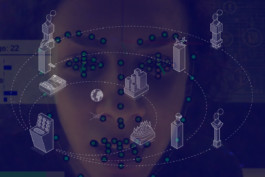
Project Details
Year
2019
Role
Game design
Researcher
Speculative design
Interaction design
Experience design
VR development
Programming support
Created for
EU Horizon 2020
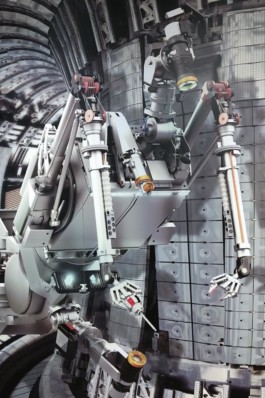
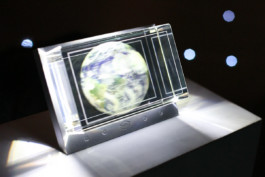
We are stuck in a strange loop. The more we create and build, the more energy we use. The more energy we use, the more the earth warms with climate change. Is there another way?
Every decision we make as a society and as individuals shapes potential futures, particularly with regards to the climate crisis. Designers are often fascinated with proposing possible futures, yet it is rare to work with scientists and statistical modelling to co-develop scenarios based on real data related to energy production, consumption and related carbon emissions.
Working closely with physicists, scientists, economists and experts in fusion energy we set about creating an experience for everyone to learn about how our individual and collective decisions impact energy futures and global greenhouse gas concentrations. Using energy-based models of the futures, we mapped out a host of scenarios taking us from today to the year 2100. These scenarios - Fragmentation, Paternalism and Harmony, would form the fulcrum of our overall design.
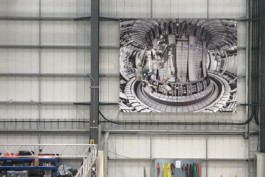
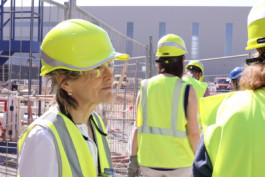
What might a future without energy scarcity look like?
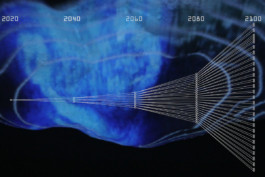
Nuclear Fusion energy is a revolutionary technology that if developed, has the potential to transform our entire relationship with energy. Its promise - abundant, clean energy that in theory has no scarcity and higher rates of efficiency than any conventional fuel. If developed this would provide the world with limitless energy for applications ranging from home heating to interplanetary transportation.
Fusion energy is recognised by the scientific community as one amongst many possible answers to the world’s energy problems, as well as the climate crisis. How it might fit into a global energy mix very much depends on the type of world in which it is developed. Its importance is highlighted by the fact that it is a rare example of a technology being developed through the international cooperation of all major nations.
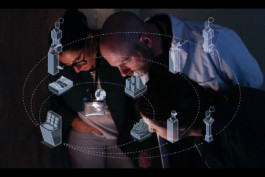

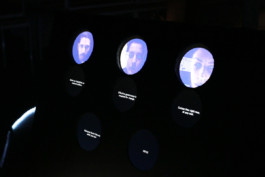
Yet the trajectory to Fusion energy is not clear. It remains a difficult challenge for a global team of researchers at ITER, many of whom are resigned to the fact that they will not see the technology come into fruition in their lifetime. It also suffers from ‘nuclear stigma’ due to a lack of awareness amongst the public over the differences between conventional nuclear fission and nuclear fusion.
To speculate on possible futures, we began to create a tree of possibilities based around the three scenarios, correlated world events, and human decision making. These were formulated using a speculative design process, might happen given a particular choice at a particular juncture. For example what would happen if we fully support clean energy now? What might occur if we prioritise our national needs over the global community? Can we really decarbonize immediately?

The decision tree featuring unique story-lines across any combination of choices
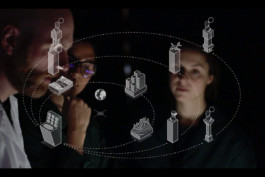
Stories were mapped to physical space - three rings representing three time periods, and generative content at three stations populated based on decisions made by the team
Each point along the decision tree reflects a particular context, set across a century long time horizon. At each point users engage with a story from that context, and are faced with a dilemma to negotiate together. The experience creates an opportunity for individuals to see how macro issues are often influenced by micro determination and the simple everyday choices of the many, which often creates a conflict between the types of futures we seek individually vs. collectively desire.
This inevitably led to a complex and varied set of outcomes, with some paths leading to a world so unsustainable that human and non-human life could simply no longer continue - a Game Over event. The game design process intentionally obfuscated 'obvious' choices or winning strategies to encourage users to reflect on their personal beliefs, before coming together as a team to share, negotiate and make a collective decision.
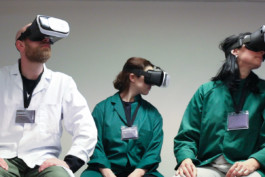
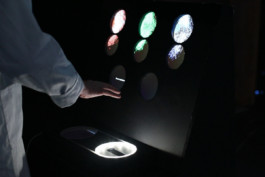
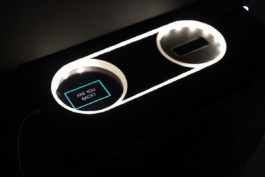
The experience takes the form of a physical installation, translating the tree of possible paths and related stories, from 2D to 3D space, at a scale which zooms out over time. This begins through an immersive experience, using a VR film personalised for each user, placing them into roles for the mission ahead. Accompanied by GAIA the AI, the team is briefed and embarks on a series of three missions through space and time.
Mission 1 begins at the outer ring in physical space. Users are transported to Copenhagen in 2030 and hear stories from individuals living in that era. After hearing three stories along the ring, the team journey back to the decision making station to share what they have learned and make a collective decision. This decision is computed by GAIA, to load the next mission and time horizon. During this time users discover how their decision influenced the intervening years across a range of factors such as carbon emissions, ecosystems and global development.
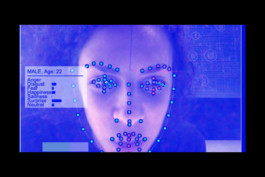
In Mission One we hear stories from individuals
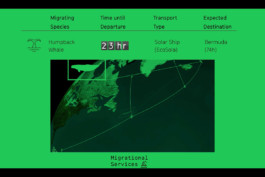
Futuristic travel options such as Migrational Services appear in Mission Two
Mission 2 is set in Seoul, 2050 and zooms out from individual stories, presenting users with a set of 3 services and products to discover, for example Migrational Services, a new carbon negative holiday service that tracks animal migration to ensure zero harm to non-human species. Content for this round is generative and reflects the decisions of users in Mission 1.
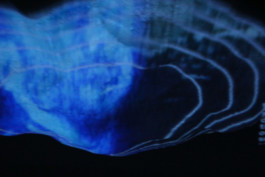
In Mission Three we explore futures through landscapes and topographies
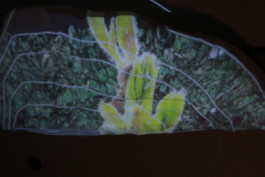
Topographical stories projection mapped on to physical forms
Mission 3 zooms out yet further to present a macro outlook for a particular region, in this case Northern Africa in 2080. A set of generative stories are presented through topographical information and geo-political events occurring in the region. These take the form of projections mapped onto physical sculptures that the team can visit.
After the final round of decision making, the team is transported to 2100. In physical space the centre-piece is activated, displaying the type of world the team has created through a 3D hologram and accompanying audio.
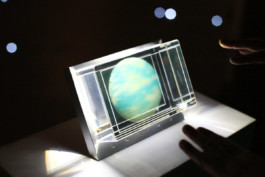

Project Credits
Created by
Cyrus Clarke, Monika Seyfried, Annelie Berner, Raffaela Rovida, Peter Otto Kunsberg
Research Lead
Raffaela Rovida
Speculative and Game design Lead
Cyrus Clarke
Content Lead
Monika Seyfried
Programming Lead
Annelie Berner
Physical Computing
Peter Otto Kunsberg
Created for
euroFUSION:
EU Horizon 2020 Fusion Energy initiative
The Strange Loop installation is due to tour Europe as part of an educational interactive installation to promote Fusion Energy Futures starting in 2021 supported by the European Union Horizon 2020.
Fusion Energy Futures

Project Details
Year
2019
Role
Game design
Speculative design
Interaction design
Experience design
VR development
Programming support
Created for
EU Horizon 2020


We are stuck in a strange loop. The more we create and build, the more energy we use. The more energy we use, the more the earth warms with climate change. Is there another way?
Every decision we make as a society and as individuals shapes potential futures, particularly with regards to the climate crisis. Designers are often fascinated with proposing possible futures, yet it is rare to work with scientists and statistical modelling to co-develop scenarios based on real data related to energy production, consumption and related carbon emissions.
Working closely with physicists, scientists, economists and experts in fusion energy we set about creating an experience for everyone to learn about how our individual and collective decisions impact energy futures and global greenhouse gas concentrations. Using energy-based models of the futures, we mapped out a host of scenarios taking us from today to the year 2100. These scenarios - Fragmentation, Paternalism and Harmony, would form the fulcrum of our overall design.

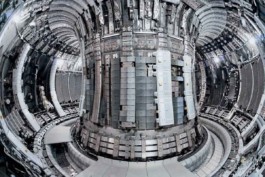
What might a future without energy scarcity look like?
Nuclear Fusion energy is a revolutionary technology that if developed, has the potential to transform our entire relationship with energy. Its promise - abundant, clean energy that in theory has no scarcity and higher rates of efficiency than any conventional fuel. If developed this would provide the world with limitless energy for applications ranging from home heating to interplanetary transportation.
Fusion energy is recognised by the scientific community as one amongst many possible answers to the world’s energy problems, as well as the climate crisis. How it might fit into a global energy mix very much depends on the type of world in which it is developed. Its importance is highlighted by the fact that it is a rare example of a technology being developed through the international cooperation of all major nations.


Yet the trajectory to Fusion energy is not clear. It remains a difficult challenge for a global team of researchers at ITER, many of whom are resigned to the fact that they will not see the technology come into fruition in their lifetime. It also suffers from ‘nuclear stigma’ due to a lack of awareness amongst the public over the differences between conventional nuclear fission and nuclear fusion.
To speculate on possible futures, we began to create a tree of possibilities based around the three scenarios, correlated world events, and human decision making. These were formulated using a speculative design process, might happen given a particular choice at a particular juncture. For example what would happen if we fully support clean energy now? What might occur if we prioritise our national needs over the global community? Can we really decarbonize immediately?



Each point along the decision tree reflects a particular context, set across a century long time horizon. At each point users engage with a story from that context, and are faced with a dilemma to negotiate together. The experience creates an opportunity for individuals to see how macro issues are often influenced by micro determination and the simple everyday choices of the many, which often creates a conflict between the types of futures we seek individually vs. collectively desire.
This inevitably led to a complex and varied set of outcomes, with some paths leading to a world so unsustainable that human and non-human life could simply no longer continue - a Game Over event. The game design process intentionally obfuscated 'obvious' choices or winning strategies to encourage users to reflect on their personal beliefs, before coming together as a team to share, negotiate and make a collective decision.



The experience takes the form of a physical installation, translating the tree of possible paths and related stories, from 2D to 3D space, at a scale which zooms out over time. This begins through an immersive experience, using a VR film personalised for each user, placing them into roles for the mission ahead. Accompanied by GAIA the AI, the team is briefed and embarks on a series of three missions through space and time.
Mission 1 begins at the outer ring in physical space. Users are transported to Copenhagen in 2030 and hear stories from individuals living in that era. After hearing three stories along the ring, the team journey back to the decision making station to share what they have learned and make a collective decision. This decision is computed by GAIA, to load the next mission and time horizon. During this time users discover how their decision influenced the intervening years across a range of factors such as carbon emissions, ecosystems and global development.

Mission 2 is set in Seoul, 2050 and zooms out from individual stories, presenting users with a set of 3 services and products to discover, for example Migrational Services, a new carbon negative holiday service that tracks animal migration to ensure zero harm to non-human species. Content for this round is generative and reflects the decisions of users in Mission 1.

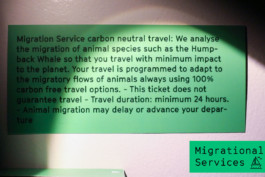
Mission 3 zooms out yet further to present a macro outlook for a particular region, in this case Northern Africa in 2080. A set of generative stories are presented through topographical information and geo-political events occurring in the region. These take the form of projections mapped onto physical sculptures that the team can visit.



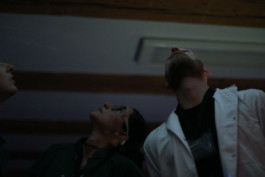
After the final round of decision making, the team is transported to 2100. In physical space the centre-piece is activated, displaying the type of world the team has created through a 3D hologram and accompanying audio.


Project Credits
Created by
Cyrus Clarke, Monika Seyfried, Annelie Berner, Raffaela Rovida, Peter Otto Kunsberg
Research Lead
Raffaela Rovida
Speculative and Game design Lead
Cyrus Clarke
Content Lead
Monika Seyfried
Programming Lead
Annelie Berner
Physical Computing
Peter Otto Kunsberg
Created for
euroFUSION:
EU Horizon 2020 Fusion Energy initiative
The Strange Loop installation is due to tour Europe as part of an educational interactive installation to promote Fusion Energy Futures starting in 2021 supported by the European Union Horizon 2020.



© Cyrus Clarke 2025